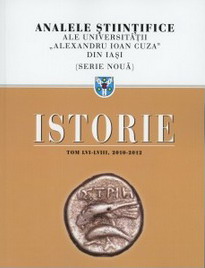Arheologia identităţii etnice
The archaeology of ethnic identity
Author(s): Nelu ZugravuSubject(s): History
Published by: Editura Universităţii »Alexandru Ioan Cuza« din Iaşi
Keywords: archaeology; ethnic identity; archaeology of identity; archaeology of ethnic identity; ethnogenesis
Summary/Abstract: The archaeology of identity represents the recent descendent of a branch of knowledge (archaeology) on the verge of expansion; as a discipline itself it seems to experience a process of enhancement, as long as the types of identity recognizable through archaeological research prove to be manifold. Within the context, on the background of conceptual and methodological incentives borrowed from anthropology and sociology, on one hand, and influenced by the political, economic and technological transformations manifested at European, global and national level, on the other hand, the archaeology of ethnic identity experienced a notably development. The author (and not only him) states a surprising fact: in spite of the indubitable contribution brought about by this branch of research in clarifying terminology issues („ethnicity”, „ethnic group”, „identity”, „alterity”, „archaeological culture”, „style”) and creating a more refined technical-methodological analysis frame (ethnic identity and other types of identities; ethnicity as a situational construct; criteria or markers of ethnic identity and their „objectivity”, etc.), the already vast professional literature provides more interrogations than answers to the ethnical identity issue, as well as numerous contradictions and „unsolvable” intricacies, that lead us to question whether this epistemological pattern bypassed the stage of sketching the theoretical structure: the (sometimes unlimited) pessimism regarding the potential of archaeology to provide any type of answer to ethnical issues; refusing (sometimes harsh) to admit the quality of „ethnical identity signs” of certain archaeological materials or their entirety and interpret them as markers of other types of identity (power, gender, age, religion, etc.); considering the „archaeological cultures” as fictions and the (great) ethno-linguistic groups as being non-historical entities; the (sometimes clear) distinction between „cultural continuity” and „ethnical continuity”; the skepticism towards the written sources and the necessity that, in order to be considered as „ethnical signs”, the archaeological materials should be in accordance with ancient or post-ancient information, etc. Finally, the author interrogates the measure in which the archaeology of the first millennium in Romania needs to change the pattern or rely on the traditional identity between the „archaeological culture” and „ethnicity”.
Journal: Analele Ştiinţifice ale Universităţii »Alexandru Ioan Cuza« din Iaşi. Istorie
- Issue Year: 2012
- Issue No: 56+58
- Page Range: 61-71
- Page Count: 11
- Language: Romanian
- Content File-PDF

